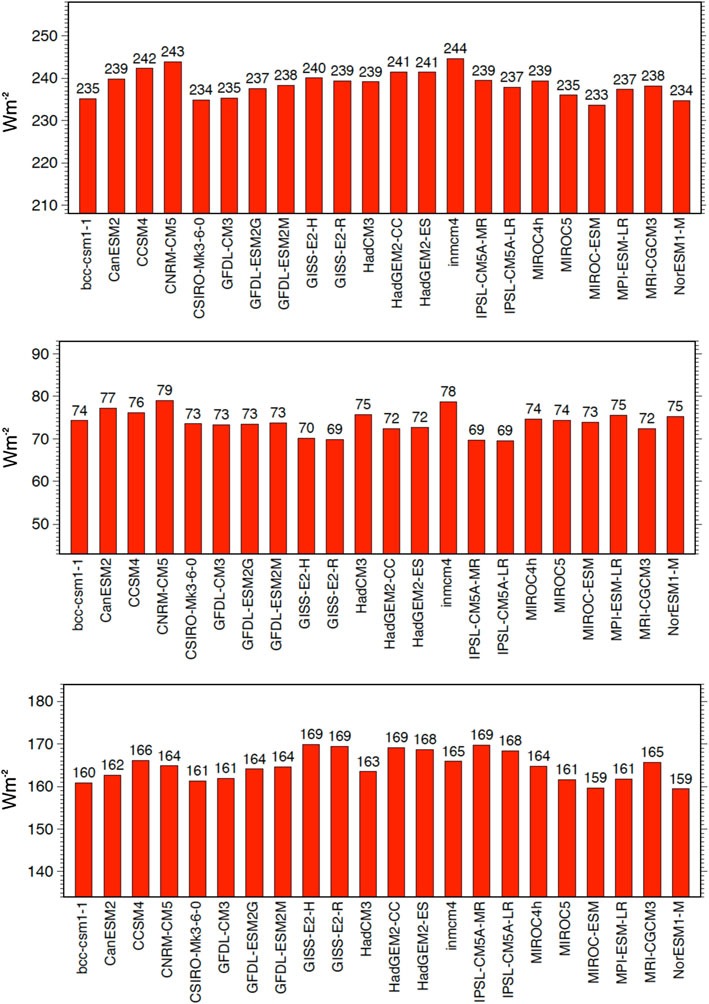Radiation and Surface Energy Budgets in Climate Models

Substantial differences exist in the representation of radiation and surface energy fluxes in climate models. We use comprehensive sets of worldwide distributed surface flux measurements combined with satellite measurements to evaluate and constrain the energy fluxes in climate models. The GEBA database provides a useful source of information for these studies. We also address related methodological aspects, such as the quantification of the error introduced by the spatial mismatch between the point observations at the surface and the larger scale of the gridded climate model data (Hakuba et al. 2013, 2014, Schwarz et al. 2017). Our studies over several generations of climate models show that globally climate models tend to overestimate the solar radiation and underestimate the thermal radiation incident at the surface (e.g., Wild et al. 1995, 1998, 2015, Wild 2008). This results in a globally realistic surface radiation balance due to error cancellation in the solar and thermal fluxes. This error cancellation, however, does no longer apply on regional, seasonal and diurnal spatial and temporal scales, inducing substantial errors in the simulation of the thermal and hydrological conditions at the Earth surface which crucially depend on an accurate surface radiation balance. Substantial uncertainties also exist in the radiation budgets under cloud-fre conditions, thus not considering the uncertainties induced by the simulation of clouds. We also make an attempt to constrain these fluxes in models using newly established observational clear-sky reference data (Wild et al. 2006, 2018).
Wild, M., Ohmura, A., Gilgen, H., and Roeckner, E., 1995: Validation of GCM simulated radiative fluxes using surface observations. J. Climate, 8, 1309-1324.
Wild, M., A. Ohmura, H. Gilgen, E. Roeckner, M. Giorgetta and J.J. Morcrette, 1998: The disposition of radiative energy in the global climate system: GCM-calculated versus observation estimates. Climate Dynamics, 14, 853-869.
Wild, M., Ohmura, A., Gilgen, H., Morcrette, J.J., and Slingo, A., 2001: Downward longwave radiation in General Circulation Models. J. Climate, 14, 3227-3239.
Wild, M., Long, C.N., and Ohmura, A., 2006: Evaluation of clear-sky solar fluxes in GCMs participating in AMIP and IPCC-AR4 from a surface perspective. J. Geophys. Res., 111, D01104, doi:10.1029/2005JD006118.
Wild, M., and Roeckner, E., 2006: Radiative fluxes in ECHAM5. J. Climate, 19, 3792-3809.
Wild, M., 2008: Shortwave and longwave surface radiation budgets in GCMs: a review based on the IPCC-AR4/CMIP3 models. Tellus, 60, 932 - 945. doi: 10.1111/j.1600-0870.2008.00342.x
Hakuba, M.Z., Folini, D., Sanchez-Lorenzo, A., and Wild, M. 2013: Spatial representativeness of ground-based solar radiation measurements, J. Geophys. Res., 118, 8585–8597, doi:10.1002/jgrd.50673.
Hakuba, M.Z., Folini, D., Sanchez-Lorenzo, A., and Wild, M. 2014: Spatial representativeness of ground-based solar radiation measurements - Extension to the full Meteosat disk. J. Geophys. Res. Atmos., 119, 11,760–11,771, doi:10.1002/2014JD021946.
Wild, M., and Co-authors 2015: The energy balance over land and oceans: An assessment based on direct observations and CMIP5 climate models, Climate Dynamics, DOI 10.1007/s00382-014-2430-z.
Schwarz, M., Folini, D., Hakuba, M.Z., and Wild, M., 2017: Spatial Representativeness of Surface-Measured Variations of Downward Solar Radiation, J. Geophys. Res., 122, 13319-13337, DOI: 10.1002/2017JD027261.
Wild, M., Hakuba, M. Z., Folini, D., Dörig-Ott, P., Schär, C. Kato, S., and Long, C.N., 2018: The cloud-free global energy balance and inferred cloud radiative effects: an assessment based on direct observations and climate models. Clim. Dyn., doi: 10.1007/s00382-018-4413-y.